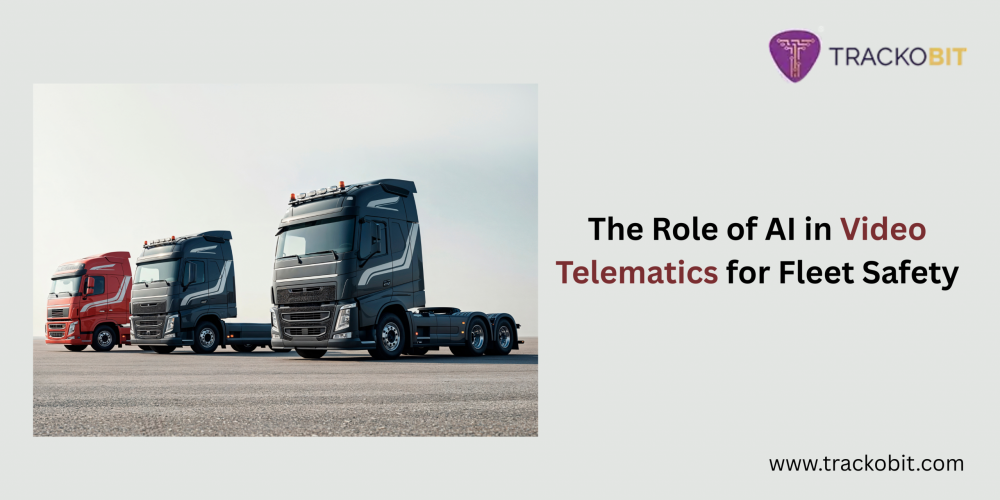Fleet safety is becoming a new phase with artificial intelligence being the leading cause of this change. Regular fleet management used to depend on GPS tracking and simple telematics, but AI-based video telematics software is transforming how the business manages and improves fleet performance.
These systems facilitate real-time analytics, reduce drivers’ risk, and bring down operational hazards. Video telematics and GPS are the two new technologies, which most people are not familiar with.
This guide will explain how AI is contributing to the proper operation of the fleet. It will also focus on minimizing the risk and why businesses should invest in these technologies
What is Video Telematics?
A video telematics solution uses dash cameras combined with telematics software to capture, analyze, and report driving behavior. The traditional type of telematics solely concentrates on GPS tracking and vehicle diagnostics, whereas video telematics solutions bring an added visual element to fleet monitoring.
How Video Telematics Works
The cameras installed in the vehicle record the real-time footage of the road and the driver’s cabin. Via AI, it processes the footage to identify signs of distraction, fatigue, harsh braking, or sudden lane departures. This system firstly informs the fleet manager or the driver if necessary and allows for correction before an accident
The Role of AI in Video Telematics
The use of artificial intelligence (AI) in the video telematics industry has helped to bring out advancements in surveillance systems. It is making them more than just mere cameras but intelligent systems.
AI is no longer just a tool for recording events. Instead, it can now predict and prevent accidents and other incidents that might arise, thus making it a life-saving tool.
- Live Streaming and Recording
One of the most important tasks of AI in video telematics systems is to be able to view real-time driving behavior of the driver. AI-enabled cameras can spot activities such as texting, talking, eating, or turning away from the road that show the driver is not fully concentrating.
The telematics software can, additionally by using eye-movement patterns, yawning, and head nodding, spot tired drivers. AI is able to produce alerts immediately, contributing to helping drivers to focus again, if it detects risky events.
- Preventive Measures
Besides supervision, AI is an important ingredient in the detection of and protection against incidents. AI-driven video telematics systems not only record video but also they can send alerts in real-time while assessing the conditions of the roads.
These systems can recognize pedestrians, surrounding vehicles, and sudden braking events thereby alerting drivers before accidents take place. The ability of AI to analyze several dangers simultaneously ensures that fleets can greatly minimize accident rates and, ultimately, better road safety.
- Performance Reviewing
AI in a video telematics system supports real-time risk scoring through driver performance metrics and predictive maintenance practices. AI grades risk scores by monitoring the behavior of the drivers and then companies may create a coaching program for one person.
The innovative methods of a company could be highly beneficial, preventing accidents by means of analytical tools and thus, ensuring to bring down the insurance and repair costs of the companies.
- Route and Fuel Monitoring
AI also helps telematics technologies optimize routes and cut fuel usage when looking for GPS tracking solutions for fleets. Telematics software from next-generation analyzes traffic flow, road conditions, and the downloading data to offer the most efficient way to carry out a trip.
This not only minimizes the time but also the operation cost by lessening idle time and fuel wastage.
GPS Fleet Tracking Solutions use geofencing and are able to locate such vehicles that are entering or exiting the prohibited area.
Legal & Insurance Benefits of AI-Powered Video Telematics
AI-powered video telematics systems deliver multiple advantages to businesses regarding legal situations and insurance programs. Businesses that employ AI-analyzed video evidence remain shielded from alleged false claims and fraudulent lawsuits following accidents or disputes.
AI goes beyond just legal protection when it comes to predictive maintenance where it can actually monitor vehicle health in real time. AI-driven telematics software is capable of diagnosing the car before it breaks down, thus, it enables fleet managers to proactively arrange maintenance. Thanks to this approach, there are reduced cases of expected downtime, vehicle life is more prolonged, and long-term maintenance costs are lowered.
The Future of Video Telematics with AI
Since AI continues to progress, video telematics solutions will also logically improve.
The AI system will then adjust speed, apply brakes, or issue voice alerts to drivers in real time. AI applications of augmented reality (AR) are thus very likely to be standardized. Because they will enable drivers to be informed of the dangers and see the right way directly on their windshields.
A most interesting development is the fusion of video telematics systems with smart city infrastructure.
With the help of AI-based systems, the whole fleet of vehicles and road facilities in the city might convert into an intelligent network of communication.
The fleets of vehicles will soon be capable of communication with traffic signals, and vehicles with internet connection. It will create a safer environment for roads.
Before You Go!
AI video telematics software is no longer optional but essential to companies to manage their fleets. Organizations that adopt these solutions such as Trackobit can expect to bring considerable benefits.
It will improve driver safety, lower accident rates and fuel consumption, and even proper safety regulations compliance to cleaner, safer, and less expensive fleet solutions.
